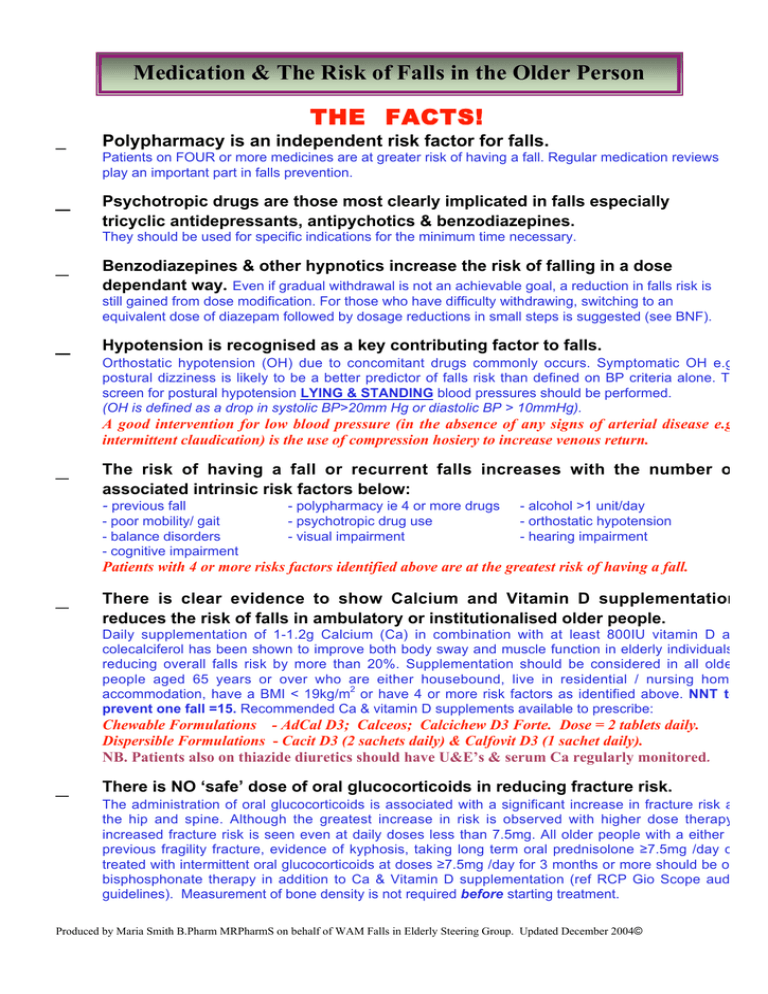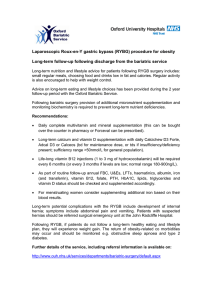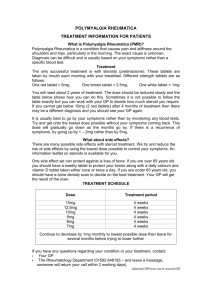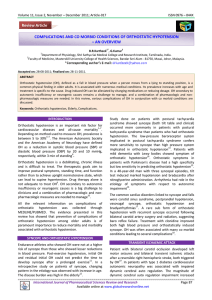THE FACTS! _ Polypharmacy is an independent risk factor for falls.
advertisement

Medication & The Risk of Falls in the Older Person THE FACTS! _ Polypharmacy is an independent risk factor for falls. Patients on FOUR or more medicines are at greater risk of having a fall. Regular medication reviews play an important part in falls prevention. _ Psychotropic drugs are those most clearly implicated in falls especially tricyclic antidepressants, antipychotics & benzodiazepines. They should be used for specific indications for the minimum time necessary. _ Benzodiazepines & other hypnotics increase the risk of falling in a dose dependant way. Even if gradual withdrawal is not an achievable goal, a reduction in falls risk is still gained from dose modification. For those who have difficulty withdrawing, switching to an equivalent dose of diazepam followed by dosage reductions in small steps is suggested (see BNF). _ Hypotension is recognised as a key contributing factor to falls. Orthostatic hypotension (OH) due to concomitant drugs commonly occurs. Symptomatic OH e.g postural dizziness is likely to be a better predictor of falls risk than defined on BP criteria alone. T screen for postural hypotension LYING & STANDING blood pressures should be performed. (OH is defined as a drop in systolic BP>20mm Hg or diastolic BP > 10mmHg). A good intervention for low blood pressure (in the absence of any signs of arterial disease e.g intermittent claudication) is the use of compression hosiery to increase venous return. _ The risk of having a fall or recurrent falls increases with the number o associated intrinsic risk factors below: - previous fall - poor mobility/ gait - balance disorders - cognitive impairment - polypharmacy ie 4 or more drugs - psychotropic drug use - visual impairment - alcohol >1 unit/day - orthostatic hypotension - hearing impairment Patients with 4 or more risks factors identified above are at the greatest risk of having a fall. _ There is clear evidence to show Calcium and Vitamin D supplementation reduces the risk of falls in ambulatory or institutionalised older people. Daily supplementation of 1-1.2g Calcium (Ca) in combination with at least 800IU vitamin D a colecalciferol has been shown to improve both body sway and muscle function in elderly individuals reducing overall falls risk by more than 20%. Supplementation should be considered in all olde people aged 65 years or over who are either housebound, live in residential / nursing hom accommodation, have a BMI < 19kg/m2 or have 4 or more risk factors as identified above. NNT to prevent one fall =15. Recommended Ca & vitamin D supplements available to prescribe: Chewable Formulations - AdCal D3; Calceos; Calcichew D3 Forte. Dose = 2 tablets daily. Dispersible Formulations - Cacit D3 (2 sachets daily) & Calfovit D3 (1 sachet daily). NB. Patients also on thiazide diuretics should have U&E’s & serum Ca regularly monitored. _ There is NO ‘safe’ dose of oral glucocorticoids in reducing fracture risk. The administration of oral glucocorticoids is associated with a significant increase in fracture risk a the hip and spine. Although the greatest increase in risk is observed with higher dose therapy increased fracture risk is seen even at daily doses less than 7.5mg. All older people with a either previous fragility fracture, evidence of kyphosis, taking long term oral prednisolone 7.5mg /day o treated with intermittent oral glucocorticoids at doses 7.5mg /day for 3 months or more should be o bisphosphonate therapy in addition to Ca & Vitamin D supplementation (ref RCP Gio Scope aud guidelines). Measurement of bone density is not required before starting treatment. Produced by Maria Smith B.Pharm MRPharmS on behalf of WAM Falls in Elderly Steering Group. Updated December 2004©




